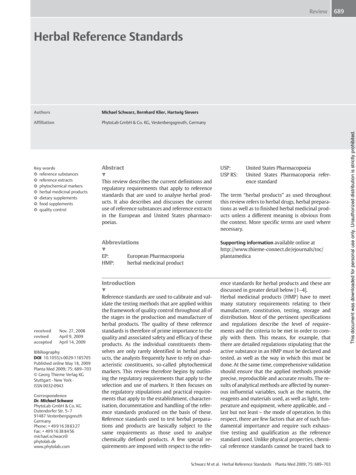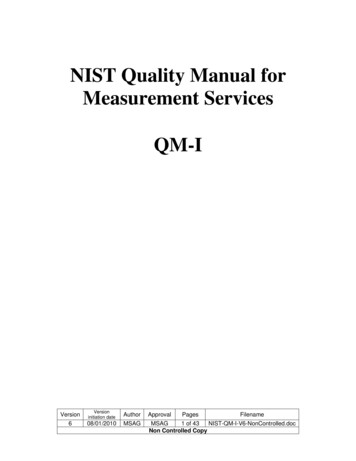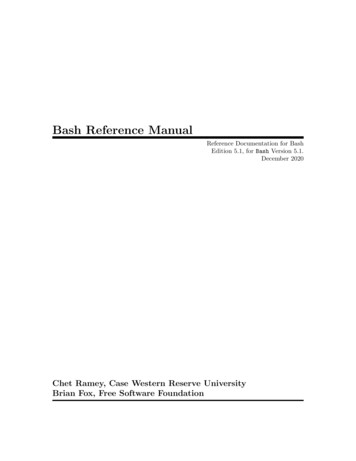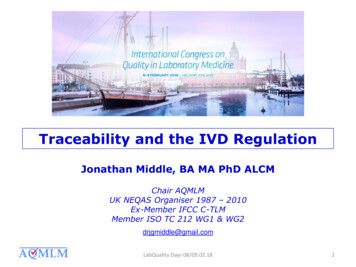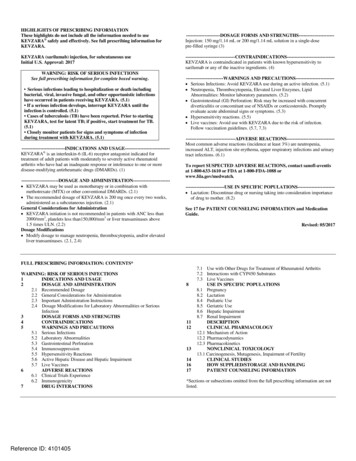
Transcription
HIGHLIGHTS OF PRESCRIBING INFORMATIONThese highlights do not include all the information needed to useKEVZARA safely and effectively. See full prescribing information forKEVZARA.KEVZARA (sarilumab) injection, for subcutaneous useInitial U.S. Approval: 2017WARNING: RISK OF SERIOUS INFECTIONSSee full prescribing information for complete boxed warning. Serious infections leading to hospitalization or death includingbacterial, viral, invasive fungal, and other opportunistic infectionshave occurred in patients receiving KEVZARA. (5.1) If a serious infection develops, interrupt KEVZARA until theinfection is controlled. (5.1) Cases of tuberculosis (TB) have been reported. Prior to startingKEVZARA, test for latent TB; if positive, start treatment for TB.(5.1) Closely monitor patients for signs and symptoms of infectionduring treatment with KEVZARA. (5.1)----------------------------INDICATIONS AND USAGE---------------------------- KEVZARA is an interleukin-6 (IL-6) receptor antagonist indicated fortreatment of adult patients with moderately to severely active rheumatoidarthritis who have had an inadequate response or intolerance to one or moredisease-modifying antirheumatic drugs (DMARDs). (1)------------------------DOSAGE AND ADMINISTRATION----------------------- KEVZARA may be used as monotherapy or in combination withmethotrexate (MTX) or other conventional DMARDs. (2.1) The recommended dosage of KEVZARA is 200 mg once every two weeks,administered as a subcutaneous injection. (2.1)General Considerations for Administration KEVZARA initiation is not recommended in patients with ANC less than2000/mm3, platelets less than150,000/mm3 or liver transaminases above1.5 times ULN. (2.2)Dosage Modifications Modify dosage to manage neutropenia, thrombocytopenia, and/or elevatedliver transaminases. (2.1, 2.4)----------------------DOSAGE FORMS AND STRENGTHS---------------------- Injection: 150 mg/1.14 mL or 200 mg/1.14 mL solution in a single-dosepre-filled syringe NS------------------------------ KEVZARA is contraindicated in patients with known hypersensitivity tosarilumab or any of the inactive ingredients. (4)------------------------WARNINGS AND PRECAUTIONS------------------------ Serious Infections: Avoid KEVZARA use during an active infection. (5.1) Neutropenia, Thrombocytopenia, Elevated Liver Enzymes, LipidAbnormalities: Monitor laboratory parameters. (5.2) Gastrointestinal (GI) Perforation: Risk may be increased with concurrentdiverticulitis or concomitant use of NSAIDs or corticosteroids. Promptlyevaluate acute abdominal signs or symptoms. (5.3) Hypersensitivity reactions. (5.5) Live vaccines: Avoid use with KEVZARA due to the risk of infection.Follow vaccination guidelines. (5.7, 7.3)--------------------------------ADVERSE REACTIONS------------------------------ Most common adverse reactions (incidence at least 3%) are neutropenia,increased ALT, injection site erythema, upper respiratory infections and urinarytract infections. (6.1)To report SUSPECTED ADVERSE REACTIONS, contact sanofi-aventisat 1-800-633-1610 or FDA at 1-800-FDA-1088 E IN SPECIFIC POPULATIONS----------------------- Lactation: Discontinue drug or nursing taking into consideration importanceof drug to mother. (8.2)See 17 for PATIENT COUNSELING INFORMATION and MedicationGuide.Revised: 05/2017FULL PRESCRIBING INFORMATION: CONTENTS*WARNING: RISK OF SERIOUS INFECTIONS1INDICATIONS AND USAGE2DOSAGE AND ADMINISTRATION2.1 Recommended Dosage2.2 General Considerations for Administration2.3 Important Administration Instructions2.4 Dosage Modifications for Laboratory Abnormalities or SeriousInfection3DOSAGE FORMS AND STRENGTHS4CONTRAINDICATIONS5WARNINGS AND PRECAUTIONS5.1 Serious Infections5.2 Laboratory Abnormalities5.3 Gastrointestinal Perforation5.4 Immunosuppression5.5 Hypersensitivity Reactions5.6 Active Hepatic Disease and Hepatic Impairment5.7 Live Vaccines6ADVERSE REACTIONS6.1 Clinical Trials Experience6.2 Immunogenicity7DRUG INTERACTIONSReference ID: 410140581112131416177.1 Use with Other Drugs for Treatment of Rheumatoid Arthritis7.2 Interactions with CYP450 Substrates7.3 Live VaccinesUSE IN SPECIFIC POPULATIONS8.1 Pregnancy8.2 Lactation8.4 Pediatric Use8.5 Geriatric Use8.6 Hepatic Impairment8.7 Renal ImpairmentDESCRIPTIONCLINICAL PHARMACOLOGY12.1 Mechanism of Action12.2 Pharmacodynamics12.3 PharmacokineticsNONCLINICAL TOXICOLOGY13.1 Carcinogenesis, Mutagenesis, Impairment of FertilityCLINICAL STUDIESHOW SUPPLIED/STORAGE AND HANDLINGPATIENT COUNSELING INFORMATION*Sections or subsections omitted from the full prescribing information are notlisted.
FULL PRESCRIBING INFORMATIONWARNING: RISK OF SERIOUS INFECTIONSPatients treated with KEVZARA are at increased risk for developing serious infectionsthat may lead to hospitalization or death [see Warnings and Precautions (5.1), AdverseReactions (6.1)]. Opportunistic infections have also been reported in patients receivingKEVZARA. Most patients who developed infections were taking concomitantimmunosuppressants such as methotrexate or corticosteroids.Avoid use of KEVZARA in patients with an active infection.Reported infections include: Active tuberculosis, which may present with pulmonary or extrapulmonary disease.Patients should be tested for latent tuberculosis before KEVZARA use and duringtherapy. Treatment for latent infection should be initiated prior to KEVZARA use. Invasive fungal infections, such as candidiasis, and pneumocystis. Patients withinvasive fungal infections may present with disseminated, rather than localized,disease. Bacterial, viral and other infections due to opportunistic pathogens.Closely monitor patients for signs and symptoms of infection during treatment withKEVZARA. If a serious infection develops, interrupt KEVZARA until the infection iscontrolled.Consider the risks and benefits of treatment with KEVZARA prior to initiating therapyin patients with chronic or recurrent infection.1 INDICATIONS AND USAGEKEVZARA is indicated for treatment of adult patients with moderately to severely activerheumatoid arthritis (RA) who have had an inadequate response or intolerance to one or moredisease-modifying antirheumatic drugs (DMARDs).2 DOSAGE AND ADMINISTRATION2.1 Recommended DosageKEVZARA may be used as monotherapy or in combination with methotrexate (MTX) or otherconventional DMARDs.The recommended dosage of KEVZARA is 200 mg once every two weeks given as asubcutaneous injection.Reference ID: 4101405
Reduce dose to 150 mg once every two weeks for management of neutropenia,thrombocytopenia and elevated liver enzymes [see Dosage and Administration (2.4), Warningsand Precautions (5.2) and Adverse Reactions (6.1)].2.2 General Considerations for Administration KEVZARA initiation is not recommended in patients with an absolute neutrophil count(ANC) less than 2000 per mm3, platelet count less than 150,000 per mm3, or who haveALT or AST above 1.5 times the upper limit of normal (ULN) [see Dosage andAdministration (2.4) and Warnings and Precautions (5.2)].Prior to initiating KEVZARA, test patients for latent tuberculosis (TB). If positive,consider treating for TB prior to KEVZARA use [see Warnings and Precautions (5.1)].Avoid using KEVZARA with biological DMARDs because of the possibility ofincreased immunosuppression and increased risk of infection. The concurrent use ofKEVZARA with biological DMARDs such as TNF antagonists, IL-1R antagonists, anti CD20 monoclonal antibodies and selective co-stimulation modulators has not beenstudied.Avoid KEVZARA use in patients with active infections [see Warnings and Precautions(5.1)].2.3 Important Administration Instructions KEVZARA is intended for use under the guidance of a healthcare professional. A patientmay self-inject KEVZARA or the patient's caregiver may administer KEVZARA.Provide proper training to patients and/or caregivers on the preparation andadministration of KEVZARA prior to use according to the Instructions for Use (IFU).Allow the pre-filled syringe to sit at room temperature for 30 minutes prior tosubcutaneous injection. Do not warm KEVZARA in any other way.Parenteral drug products should be inspected visually for particulate matter anddiscoloration prior to administration. KEVZARA solution should be clear and colorless topale yellow. Do not use if the solution is cloudy, discolored or contains particles, or ifany part of the pre-filled syringe appears to be damaged.Instruct patients to inject the full amount in the syringe (1.14 mL), which provides 200mg or 150 mg of KEVZARA, according to the directions provided in the IFU.Rotate injection sites with each injection. Do not inject into skin that is tender, damaged,or has bruises or scars.2.4 Dosage Modifications for Laboratory Abnormalities or Serious InfectionIf a patient develops a serious infection, hold treatment with KEVZARA until the infection iscontrolled.Modify dosage in case of neutropenia, thrombocytopenia or liver enzyme elevations (see Table1). For treatment initiation criteria, see [Dosage and Administration (2.2)].Reference ID: 4101405
Table 1: KEVZARA Dosage Modification for Neutropenia, Thrombocytopenia, orElevated Liver EnzymesLow Absolute Neutrophil Count (ANC)[see Warnings and Precautions (5.2) and Clinical Pharmacology (12.2)]Lab Value (cells/mm3)RecommendationANC greater than 1000Maintain current dosage of KEVZARA.ANC 500-1000Hold treatment with KEVZARA until ANC greater than 1000.KEVZARA can then be resumed at 150 mg every two weeks andincreased to 200 mg every two weeks as clinically appropriate.ANC less than 500Discontinue KEVZARA.Low Platelet Count[see Warnings and Precautions (5.2)]Lab Value (cells/mm3)Recommendation50,000-100,000Hold treatment with KEVZARA until platelets greater than 100,000.KEVZARA can then be resumed at 150 mg every two weeks andincreased to 200 mg every two weeks as clinically appropriate.Less than 50,000If confirmed by repeat testing, discontinue KEVZARA.Liver Enzyme Abnormalities[see Warnings and Precautions (5.2)]Lab ValueRecommendationALT greater than ULN to Consider dosage modification of concomitant DMARDs as3 times ULN or lessclinically appropriate.ALT greater than 3 times Hold treatment with KEVZARA until ALT less than 3 times ULN.ULN to 5 times ULN orKEVZARA can then be resumed at 150 mg every two weeks andlessincreased to 200 mg every two weeks as clinically appropriate.ALT greater than 5 times Discontinue KEVZARA.ULN3 DOSAGE FORMS AND STRENGTHSInjection: 150 mg/1.14 mL or 200 mg/1.14 mL colorless to pale-yellow solution in a single-dosepre-filled syringe.4 CONTRAINDICATIONSKEVZARA is contraindicated in patients with known hypersensitivity to sarilumab or any of theinactive ingredients [see Warnings and Precautions (5.5) and Adverse Reactions (6.1)].5 WARNINGS AND PRECAUTIONS5.1 Serious InfectionsReference ID: 4101405
Serious and sometimes fatal infections due to bacterial, mycobacterial, invasive fungal, viral, orother opportunistic pathogens have been reported in patients receiving immunosuppressiveagents including KEVZARA for rheumatoid arthritis (RA). The most frequently observedserious infections with KEVZARA included pneumonia and cellulitis [see Adverse Reactions(6.1)]. Among opportunistic infections, tuberculosis, candidiasis, and pneumocystis werereported with KEVZARA. Some patients presented with disseminated rather than localizeddisease and were often taking concomitant immunosuppressants such as methotrexate orcorticosteroids, which in addition to RA may predispose them to infections. While not reportedin KEVZARA clinical studies, other serious infections (e.g., histoplasmosis, cryptococcus,aspergillosis) have been reported in patients receiving other immunosuppressive agents for thetreatment of RA.Avoid use of KEVZARA in patients with an active infection, including localized infections.Consider the risks and benefits of treatment prior to initiating KEVZARA in patients who have: chronic or recurrent infection; a history of serious or opportunistic infections; underlying conditions, in addition to RA, that may predispose them to infection; been exposed to tuberculosis; or lived in or traveled to areas of endemic tuberculosis or endemic mycoses.Closely monitor patients for the development of signs and symptoms of infection duringtreatment with KEVZARA, as signs and symptoms of acute inflammation may be lessened dueto suppression of the acute phase reactants [see Dosage and Administration (2.4), AdverseReactions (6.1)].Hold treatment with KEVZARA if a patient develops a serious infection or an opportunisticinfection.Perform a prompt and complete diagnostic testing appropriate for an immunocompromisedpatient who develops a new infection during treatment with KEVZARA; initiate appropriateantimicrobial therapy, and closely monitor the patient.Reference ID: 4101405
TuberculosisEvaluate patients for tuberculosis (TB) risk factors and test for latent infection prior to initiatingtreatment with KEVZARA. Treat patients with latent TB with standard antimycobacterialtherapy before initiating KEVZARA. Consider anti-TB therapy prior to initiation of KEVZARAin patients with a past history of latent or active TB in whom an adequate course of treatmentcannot be confirmed, and for patients with a negative test for latent TB but having risk factors forTB infection. When considering anti-TB therapy, consultation with a physician with expertise inTB may be appropriate.Closely monitor patients for the development of signs and symptoms of TB including patientswho tested negative for latent TB infection prior to initiating therapy.Viral ReactivationViral reactivation has been reported with immunosuppressive biologic therapies. Cases of herpeszoster were observed in clinical studies with KEVZARA [see Adverse Reactions (6.1)]. The riskof Hepatitis B reactivation with KEVZARA is unknown since patients who were at risk forreactivation were excluded.5.2 Laboratory AbnormalitiesNeutropeniaTreatment with KEVZARA was associated with a higher incidence of decrease in absoluteneutrophil count (ANC), including neutropenia [see Adverse Reactions (6.1)]. Assess neutrophil count prior to initiation of KEVZARA and monitor neutrophil count 4to 8 weeks after start of therapy and every 3 months thereafter [see ClinicalPharmacology (12.2)]. For recommendations regarding initiating KEVZARA therapyand dosage modifications based on ANC results see [Dosage and Administration (2.2)and (2.4)]. Based on the pharmacodynamics of the changes in ANC [see Clinical Pharmacology(12.2)], use results obtained at the end of the dosing interval when considering dosemodification.ThrombocytopeniaTreatment with KEVZARA was associated with a reduction in platelet counts in clinical studies[see Adverse Reactions (6.1)]. Assess platelet count prior to initiation of KEVZARA and monitor platelets 4 to 8 weeksafter start of therapy and every 3 months thereafter. For recommendations regardinginitiating KEVZARA therapy and dosage modifications based on platelet counts see[Dosage and Administration (2.2) and (2.4)].Elevated Liver EnzymesReference ID: 4101405
Treatment with KEVZARA was associated with a higher incidence of transaminase elevations.These elevations were transient and did not result in any clinically evident hepatic injury inclinical studies [see Adverse Reactions (6.1)]. Increased frequency and magnitude of theseelevations were observed when potentially hepatotoxic drugs (e.g., MTX) were used incombination with KEVZARA. Assess ALT/AST levels prior to initiation of KEVZARA and monitor ALT and ASTlevels 4 to 8 weeks after start of therapy and every 3 months thereafter. When clinicallyindicated, consider other liver function tests such as bilirubin. For recommendationsregarding initiating KEVZARA therapy and dosage modifications based on transaminaseelevations see [Dosage and Administration (2.2) and (2.4)].Lipid AbnormalitiesTreatment with KEVZARA was associated with increases in lipid parameters such as LDLcholesterol, HDL cholesterol and/or triglycerides [see Adverse Reactions (6.1)]. Assess lipid parameters approximately 4 to 8 weeks following initiation of treatment withKEVZARA, then at approximately 6 month intervals. Manage patients according to clinical guidelines for the management of hyperlipidemia.5.3 Gastrointestinal PerforationGastrointestinal perforations have been reported in clinical studies, primarily as complications ofdiverticulitis. GI perforation risk may be increased with concurrent diverticulitis or concomitantuse of NSAIDs or corticosteroids. Promptly evaluate patients presenting with new onsetabdominal symptoms [see Adverse Reactions (6.1)].5.4 ImmunosuppressionTreatment with immunosuppressants may result in an increased risk of malignancies. The impactof treatment with KEVZARA on the development of malignancies is not known butmalignancies were reported in clinical studies [see Adverse Reactions (6.1)].5.5 Hypersensitivity ReactionsHypersensitivity reactions have been reported in association with KEVZARA [see AdverseReactions (6.1)]. Hypersensitivity reactions that required treatment discontinuation werereported in 0.3% of patients in controlled RA trials. Injection site rash, rash, and urticaria werethe most frequent hypersensitivity reactions. Advise patients to seek immediate medical attentionif they experience any symptoms of a hypersensitivity reaction. If anaphylaxis or otherhypersensitivity reaction occurs, stop administration of KEVZARA immediately. Do notadminister KEVZARA to patients with known hypersensitivity to sarilumab [seeContraindications (4) and Adverse Reactions (6.1)].5.6 Active Hepatic Disease and Hepatic ImpairmentTreatment with KEVZARA is not recommended in patients with active hepatic disease orhepatic impairment, as treatment with KEVZARA was associated with transaminase elevations[see Adverse Reactions (6.1), Use in Specific Populations (8.6)].Reference ID: 4101405
5.7 Live VaccinesAvoid concurrent use of live vaccines during treatment with KEVZARA due to potentiallyincreased risk of infections; clinical safety of live vaccines during KEVZARA treatment has notbeen established. No data are available on the secondary transmission of infection from personsreceiving live vaccines to patients receiving KEVZARA. The interval between live vaccinationsand initiation of KEVZARA therapy should be in accordance with current vaccination guidelinesregarding immunosuppressive agents [see Drug Interactions (7.3)].6 ADVERSE REACTIONSThe following serious adverse reactions are described elsewhere in labeling: Serious infections [see Warnings and Precautions (5.1)]Neutropenia, thrombocytopenia, elevated liver enzymes, lipid abnormalities [seeWarnings and Precautions (5.2)]Gastrointestinal perforation [see Warnings and Precautions (5.3)]Immunosuppression [see Warnings and Precautions (5.4)]Hypersensitivity reactions [see Warnings and Precautions (5.5)]6.1 Clinical Trials ExperienceBecause clinical studies are conducted under widely varying conditions, adverse reaction ratesobserved in the clinical studies of a drug cannot be directly compared to rates in the clinicalstudies of another drug and may not reflect the rates observed in practice.All patients in the safety data described below had moderately to severely active rheumatoidarthritis.The safety of KEVZARA in combination with conventional DMARDs was evaluated based ondata from seven studies, of which two were placebo-controlled, consisting of 2887 patients(long-term safety population). Of these, 2170 patients received KEVZARA for at least 24 weeks,1546 for at least 48 weeks, 1020 for at least 96 weeks, and 624 for at least 144 weeks.The pre-rescue placebo-controlled population includes patients from the two Phase 3 efficacystudies (Studies 1 and 2) from weeks 0 to 16 for Study 1 and weeks 0 to 12 for Study 2, and wasused to assess common adver
Table 1: KEVZARA Dosage Modification for Neutropenia, Thrombocytopenia, or Elevated Liver Enzymes


